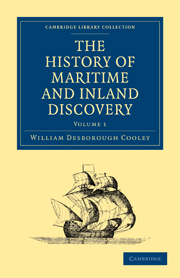CHAP. I - THE ARABIANS
Published online by Cambridge University Press: 05 July 2011
Summary
The geography of the ancients may be considered as having attained its greatest accuracy and comprehensiveness in the age of Ptolemy. The disorders which soon after followed in the Roman empire, the frequent migrations of the northern nations, and the invasions of the Goths and Huns, completely changed the geography of Europe, and rendered it difficult to procure any positive details amidst the disorders of so many revolutions.
Yet geography was still cultivated in the Roman world, and several treatises and itineraries remain, interesting to the critic, but of little importance in a general view. Of the itineraries the Romans had two kinds, the Picta and Annotata, or the drawn and written: the latter contained the names of the stations and chief places, with their distances from one another, without entering into any detail. In the Itineraria Picta, which were much more complete, all the great roads were drawn, the name and extent of the different provinces added, with the number of the inhabitants, the mountains, rivers, and neighbouring seas. But in all those monuments of Roman industry there is no trace of mathematical geography; no scientific measurement; the distances of places were ascertained merely by itinerary measures, or occasionally by observations of latitude. Pliny complains bitterly of the inaccuracy of those measures. Of the former kind of itinerary the most remarkable that remain to us are that called the Itinerary of Antonine, the age of which it is difficult to ascertain; and the Itinerary of Jerusalem, a fragment which points out in great detail the whole route from Bourdeaux to that city.
- Type
- Chapter
- Information
- The History of Maritime and Inland Discovery , pp. 154 - 173Publisher: Cambridge University PressPrint publication year: 2010First published in: 1830



